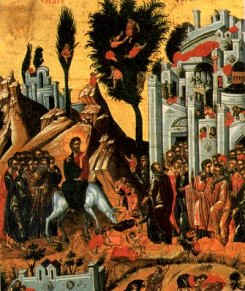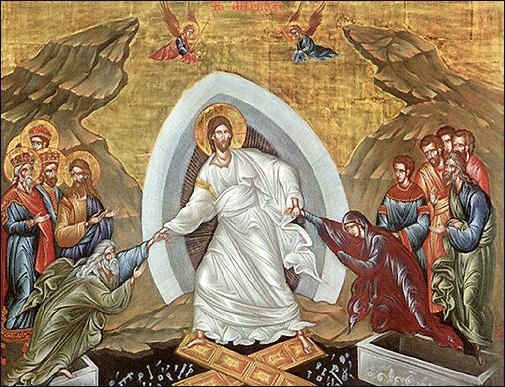
THE RESURRECTION AND THE WILLOW
In
Slavic lands the willows grow,
By streams and bogs and waters low.
The ancient Slavic peoples saw,
That willows bloom before the thaw,
When warm winds end the frigid cold,
And break, at last, the winter's hold,
To greet the spring and celebrate,
The vernal advent's advocate,
Of growth, renewal, life and light,
And set the cosmic order right.
The Slavic peoples gathered in,
The flow'ring willow branches in,
Their homes to decorate anew,
To cure their ills, their lives renew.
Then one day there came from far,
A new religion which would bar,
The grasp of ancient evils' hold,
Upon the Slavic souls as told,
By True Glory's saving creeds,
To grant men life and serve their needs.
The Word Made Flesh who lived and died,
And rose again as verified,
By Holy Writ and voices old,
Who testified as was foretold.
Christ is risen from the dead,
And by His death as truly said,
He trampled death and life He gave,
To those who lie within the grave.
And thus the lowly willow came,
The Resurrection to proclaim,
Bear witness to the Great Event,
For which the Holy One was sent.
So when the cold of winter ends,
The message that the willow sends,
And that the flow'ry branches say:
NEXT WEEK IS RESURRECTION DAY!

 Palm
Sunday, which is called Flowery Sunday or Willow Sunday in the Eastern
Churches of Byzantine/Slavic liturgical tradition, is observed by many
customs unique to the Slavs. The most important of these is the ritual
use of flowering willow branches (pussy willows) in the processions
of that day. Conventional wisdom has it that the Eastern Slavs used
pussy willows because palm trees do not grow in northern Europe. While
it is true that palm trees do not grow in northern Europe, that fact
has no bearing on the Slavic customs associated with Flowery Sunday.
The pre-Christian Slavs endowed the pussy willow with energizing properties.
The willow haralded the end of harsh winter and the renewal of spring,
while protecting people and livestock from diseases, the homes from
lightening and misfortune and by fostering the fertility of man and
beast. Palm
Sunday, which is called Flowery Sunday or Willow Sunday in the Eastern
Churches of Byzantine/Slavic liturgical tradition, is observed by many
customs unique to the Slavs. The most important of these is the ritual
use of flowering willow branches (pussy willows) in the processions
of that day. Conventional wisdom has it that the Eastern Slavs used
pussy willows because palm trees do not grow in northern Europe. While
it is true that palm trees do not grow in northern Europe, that fact
has no bearing on the Slavic customs associated with Flowery Sunday.
The pre-Christian Slavs endowed the pussy willow with energizing properties.
The willow haralded the end of harsh winter and the renewal of spring,
while protecting people and livestock from diseases, the homes from
lightening and misfortune and by fostering the fertility of man and
beast.
With the
conversion of the Slavs to Christianity, their willow customs were often
adapted to the requirements of the new faith, finding application in
the processions of Flowery Sunday to recall Our Lord's triumphant entry
into Jerusalem, but more properly going beyond Great and Holy Week as
a unitive symbol of the renewal of life fully revealed in the Glorious
Resurrection. Thus we see in the folk art and customs associated with
the Resurrection the use of flowering willows as a decorative item on
pisanki cloths and on the Easter baskets and table, and for the remainder
of the year they were placed behind the icons and crucifixes. Crosses
made of blessed willow branches were buried in the ground to protect
the crops for hail. Children swallowed the catkins as remedy for colds
and the branches, which contain acetylsalicylic acid (aspirin) were
boiled and the infusion drunk to treat pains and fever. The faithful
were encouraged to plant the willow branches used in the processions
of Flowery Sunday around their homes and outbuildings to protect man
and beast from harm. Many of these quasi-sacramental uses of the willow
persist to this day.
More important
to Eastern Christians of Byzantine/Slavic liturgical tradition are the
quasi-liturgical customs, many of which found their way to America with
the migration of Slavs from Europe. Those customs like many other religious
traditions derive from and support important doctrines of the faith
and, interestingly, are found among most Slavs whether Orthodox, Greek
Catholic or Roman Catholic. When one sees Ruthenians, Russians or Ukrainians
striking one another on the shoulder on Flowery Sunday with the willow
branch and reciting the verse: "It is not I but the willow branch which
strikes you to remind you that in seven days is the Great Day", we are
all reminded by the willow branch as symbol of life that Christ is risen
from the dead, that by His death He trampled death and to those in the
graves He granted life.
There
are many folk verses associated with the ritual use of willows on Flowery
Sunday and below are a few.

UKRAINIAN
VERSE
It
is not I who beat you,
It is the willow.
In seven days is the Great Day.
The red painted eggs are very near.
Be mighty like a willow,
Be healthy like water,
And rich like the earth.
POLISH
VERSE
The
willow hits but does not kill,
And cuts the flesh once a year.
The Great Day is one week away.
BELORUSSIAN
VERSE
I
do not beat you; it is the willow that beats,
In a week it will be Easter;
Let disease flee to the forest, into the swamps,
And health return to the bones,
Be healthy like the water,
And grow like the willow,
Be healthy for the whole year,
Be happy like the spring,
Be hardy like the winter.


Return
to Index.
Copyright
© 2001-2003 by Robert L. Schwind.
All rights reserved.
|


 Palm
Sunday, which is called Flowery Sunday or Willow Sunday in the Eastern
Churches of Byzantine/Slavic liturgical tradition, is observed by many
customs unique to the Slavs. The most important of these is the ritual
use of flowering willow branches (pussy willows) in the processions
of that day. Conventional wisdom has it that the Eastern Slavs used
pussy willows because palm trees do not grow in northern Europe. While
it is true that palm trees do not grow in northern Europe, that fact
has no bearing on the Slavic customs associated with Flowery Sunday.
The pre-Christian Slavs endowed the pussy willow with energizing properties.
The willow haralded the end of harsh winter and the renewal of spring,
while protecting people and livestock from diseases, the homes from
lightening and misfortune and by fostering the fertility of man and
beast.
Palm
Sunday, which is called Flowery Sunday or Willow Sunday in the Eastern
Churches of Byzantine/Slavic liturgical tradition, is observed by many
customs unique to the Slavs. The most important of these is the ritual
use of flowering willow branches (pussy willows) in the processions
of that day. Conventional wisdom has it that the Eastern Slavs used
pussy willows because palm trees do not grow in northern Europe. While
it is true that palm trees do not grow in northern Europe, that fact
has no bearing on the Slavic customs associated with Flowery Sunday.
The pre-Christian Slavs endowed the pussy willow with energizing properties.
The willow haralded the end of harsh winter and the renewal of spring,
while protecting people and livestock from diseases, the homes from
lightening and misfortune and by fostering the fertility of man and
beast.